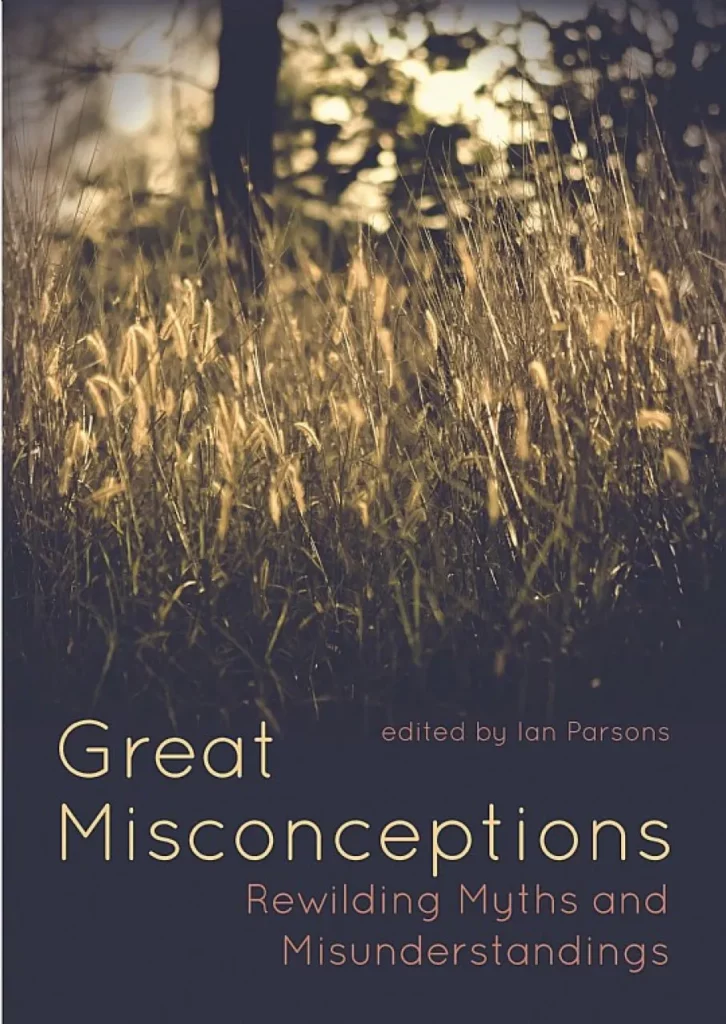Great Misconceptions: Rewilding Myths and Misunderstandings
Ian Parsons

From the outset, it should be stated that this book – a collection of essays – is probably not for those with only a passing interest in nature and rewilding. It presents the scientific and cultural tapestry of rewilding with an expectation that the reader is either professionally or strongly personally invested in the subject, so I would not, for example, order it for your great uncle who has just found a new delight in feeding garden birds (which I know at least one of the authors would discourage due to the disease risks anyway!).
With that made clear, Great Misconceptions: Rewilding Myths and Misunderstandings is a meaty tome that provides some excellent and timely material to chew on. While rewilding has been around for over 30 years in some corners of conservation biology, particularly in North America, it entered popular consciousness in Britain following the publication of George Monbiot’s Feral in 2013. Consequently, Isabella Tree embedded it into the conservation conversation even further in 2018 with the publication of Wilding, so that it has now become comfortably lodged within the discussion.
The emergence of ‘rewilding’ within the conservation sphere has reinvigorated many landowners and NGOs and in other places perhaps stirred a reassessment of priorities; to see this, you only have to look at virtually every Wildlife Trust rebranding its campaigns as ‘wilder’, or the vast number of estates who are removing sheep and putting up beaver fences. In fact, the significance of rewilding within conservation and wildlife discourse can be found in this very publication, which has been running its own ’Wilding for Conservation’ series since 2021.
Naturally, as the rewilding movement continues to grow, questions arise over whether we are on the correct course in terms of what we can be doing better, and when we need to push the brakes on what could be described as ‘wilding-washing’. The authors within this collection have been given refreshing liberty to critically assess without having to tow a brand or party-line. It is quite a relief to not hear every project simply being described as ‘wonderful’!
The definition of ‘rewilding’ inevitably comes under scrutiny and as the variation of contexts in this collection allude to, it is not one-size-fits-all. Readers should not look for a definitive answer to that here. Throughout Great Misconceptions, ideas of what rewilding is thought to be are firmly challenged. For example, Eoghan Daltun offers a passionate argument from lived experience of restoring an Irish Atlantic rainforest; he sees rewilding in this context as anything but removing people from landscapes, and instead envisions a carefully overseen process. Similarly, Chris Sperring offers a brilliantly scathing critique of how his local council tree-bombed a site with no ecological or social integrity under the guise of a ‘rewilding’ project.
As the collection is written without fear of challenging perceived or marketed norms, some readers in the ‘industry’ may find themselves shuffling at some uncomfortable truths or re-evaluating preconceived biases. As someone who works with species reintroductions, I supported many points in Ian Carter and Alex Lees’ chapter on how some cases of species translocations can be ‘dewilding’, while disagreeing with some of their ideas. This is meaty debate-style writing that feels like it could continue in a friendly argument at the pub!
Not all essays struck such a chord, however. The chapters on rewilding politics by Natalie Bennett, former leader of the Green Party, and rewilding business by Sam Varney, co-founder of Silverstick – a sustainable clothing company – read like the authors are struggling to find ways to incorporate a selection of rewilding keywords into their own professional arena, creating confused pieces that seemed to stretch the relevance.
For professionals and those with a strong interest in conservation and rewilding, this tome is a critical review of the field that provides not only a reality check but also a vital opportunity for us to re-evaluate our own motivations. Rewilding is here to stay and that’s a good thing – and to really get the best out of it, sometimes we must be our own greatest critics.
View this book on the NHBS website
Reviewed by Pete Cooper
Pete Cooper is the Species Recovery Lead at Restore and has worked on the reintroduction and wilding of of various native species including Glow-worms, Water Voles and Wildcats
